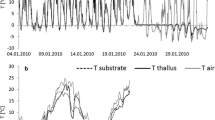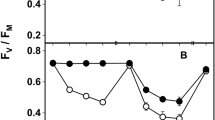Summary
The effect of high light levels on the two partners of a Pseudocyphellaria phycosymbiodeme (Pseudocyphellaria rufovirescens, with a green phycobiont, and P. murrayi with a blue-green phycobiont), which naturally occurs in deep shade, was examined and found to differ between the partners. Green algae can rapidly accumulate zeaxanthin, which we suggest is involved in photoprotection, through the xanthophyll cycle. Blue-green algae lack this cycle, and P. murrayi did not contain or form any zeaxanthin under our experimental conditions. Upon illumination, the thallus lobes with green algae exhibited strong nonphotochemical fluorescence quenching indicative of the radiationless dissipation of excess excitation energy, whereas thallus lobes with blue-green algae did not possess this capacity. The reduction state of photosystem II was higher by approximately 30% at each PFD beyond the light-limiting range in the blue-green algal partner compared with the green algal partner. Furthermore, a 2-h exposure to high light levels resulted in large reductions in the efficiency of photosynthetic energy conversion which were rapidly reversible in the lichen with green algae, but were long-lasting in the lichen with blue-green algae. Changes in fluorescence characteristics indicated that the cause of the depression in photosynthetic energy conversion was a reversible increase in radiationless dissipation in the green algal partner and “photoinhibitory damage” in the blue-green algal partner. These findings represent further evidence that zeaxanthin is involved in the photoprotective dissipation of excessive excitation energy in photosynthetic membranes. The difference in the capacity for rapid zeaxanthin formation between the two partners of the Pseudocyphellaria phycosymbiodeme may be important in the habitat selection of the two species when living separate from one another.
Similar content being viewed by others
Abbreviations
- F O :
-
yield of instantaneous fluorescence
- F M :
-
maximum yield of fluorescence induced by pulses of saturating light
- F V :
-
yield of variable fluorescence (F M -FO) induced by pulses of saturating light
- PFD :
-
photon flux density (400–700 nm)
- PS II:
-
photosystem II
- q NP :
-
coefficient for nonphotochemical fluorescence quenching
- q P (or 1-q P ):
-
coefficient for photochemical fluorescence quenching
References
Adams WW III, Smith SD, Osmond CB (1987) Photoinhibition of the CAM succulent Opuntia basilaris growing in Death Valley: evidence from 77 K fluorescence and quantum yield. Oecologia 71:221–228
Adams III WW, Díaz M, Winter K (1989) Diurnal changes in photochemical efficiency, the reduction state of Q, radiationless energy dissipation, and nonphotochemical chlorophyll fluorescence quenching in cacti exposed to natural sunlight in northern Venezuela. Oecologia 80:553–561
Adams III WW, Demmig-Adams B, Winter K (1990) Relative contributions of zeaxanthin-related and zeaxanthin-unrelated types of “high-energy-state” quenching of chlorophyll fluorescence in spinach leaves exposed to various environmental conditions. Plant Physiol 92:302–309
Bilger W, Björkman O, Thayer SS (1989) Light-induced spectral absorbance changes in relation to photosynthesis and the epoxidation state of xanthophyll cycle components in cotton leaves. Plant Physiol 91:542–551
Björkman O, Demmig B, Andrews TJ (1988) Mangrove photosynthesis: Response to high-irradiance stress. Aust J Plant Physiol 15:43–61
Demmig B, Björkman O (1987) Comparison of the effect of excessive light on chlorophyll fluorescence (77) and photon yield of O2 evolution in leaves of higher plants. Planta 171:171–184
Demmig B, Winter K, Krüger A, Czygan F-C (1987) Photoinhibition and zeaxanthin formation in intact leaves. A possible role of the xanthophyll cycle in the dissipation of excess light energy. Plant Physiol 84:218–224
Demmig B, Winter K, Krüger A, Czygan F-C (1988) Zeaxanthin and the heat dissipation of excess light energy in Nerium oleander exposed to a combination of high light and water stress. Plant Physiol 87:17–24
Demmig-Adams B, Adams III WW, Winter K, Meyer A, Schreiber U, Pereira JS, Krüger A, Czygan F-C, Lange OL (1989a) Photochemical efficiency of photosystem II, photon yield of O2 evolution, photosynthetic capacity, and carotenoid composition during the “midday depression” of net CO2 uptake in Arbutus unedo growing in Portugal. Planta 177:377–387
Demmig-Adams B, Winter K, Krüger A, Czygan F-C (1989b) Light response of CO2 assimilation, dissipation of excess excitation energy, and zeaxanthin content of sun and shade leaves. Plant Physiol 90:881–886
Demmig-Adams B, Adams III WW, Czygan F-C, Schreiber U, Lange OL (1990a) Differences in the capacity for radiationless energy dissipation in the photochemical apparatus of green and blue-green algal lichens associated with differences in carotenoid composition. Planta 180:582–589
Demmig-Adams B, Adams III WW, Heber U, Neimanis S, Winter K, Krüger A, Czygan F-C, Bilger W, Björkman O (1990b) Inhibition of zeaxanthin formation and of rapid changes in radiationless energy dissipation by dithiothreitol in spinach leaves and chloroplasts. Plant Physiol 92:293–301
Demmig-Adams B, Björkman O, Bilger W, Adams III WW, Thayer SS, Shih C (1990c) Diurnal changes in zeaxanthin content and radiationless energy dissipation in leaves of field-grown cotton (Gossypium hirsutum L.). Physiol Plant, in press
Demmig-Adams B, Máguas C, Adams III WW, Meyer A, Kilian E, Lange OL (1990d) Effect of high light on the efficiency of photochemical energy conversion in a variety of lichen species with green and blue-green phycobionts. Planta 180:400–409
Galloway DJ (1985) Flora of New Zealand Lichens. PD Hasselberg, Government Printer, Wellington
Galloway DJ (1988) Studies in Pseudocyphellaria (lichens). I. The New Zealand species. Bull Br Mus nat Hist (Bot) 17:1–267
Hager A (1980) The reversible, light-induced conversions of xanthophylls in the chloroplast. In: F-C Czygan (ed) Pigments in Plants. Fischer, Stuttgart. pp 57–79
Hager A, Stransky H (1970) Das Carotinoidmuster und die Verbreitung des lichtinduzierten Xanthophyllcyclus in verschiedenen Algenklassen. III. Grünalgen. Arch Mikrobiol 72:68–83
Horton P, Hague A (1988) Studies on the induction of chlorophyll fluorescence quenching in isolated barley chloroplasts. IV. Resolution of nonphotochemical quenching. Biochim. Biophys Acta 932:107–115
James PW, Henssen A (1976). The morphological and taxonomic significance of cephalodia. In: Brown DH, Hawksworth DL, Bailey EH (eds) Lichenology: Progress and problems. Academic press, London New York, pp 27–77
Kitajima M, Butler WL (1975) Quenching of chlorophyll fluorescence and primary photochemistry in chloroplasts by dibromothymoquinone. Biochim Biophys Acta 376:105–115
Krause GH, Behrend U (1986) ΔpH-dependent chlorophyll fluorescence quenching indicating a mechanism of protection against photoinhibition of chloroplasts. FEBS Lett 200:298–302
Krinsky NI (1979) Carotenoid protection against oxidation. Pure Appl Chem 51:649–660
Lange OL, Kilian E, Ziegler H (1986) Water vapor uptake and photosynthesis of lichens: performance differences in species with green and blue-green algae as phycobionts. Oecologia 71:104–110
Lange OL, Green TGA, Ziegler H (1988) Water status related photosynthesis and carbon isotope discrimination in species of the lichen genus Pseudocyphellaria with green or blue-green photobionts and in photosymbiodemes. Oecologia 75:494–501
Renner B, Galloway DJ (1982) Phycosymbiodemes in Pseudocyphellaria in New Zealand. Mycotaxon 16:197–231
Schäfer C, Björkman O (1989) Relationship between efficiency of photosynthetic energy conversion and chlorophyll fluorescence quenching in Upland cotton (Gossypium hirsutum L.). Planta 178:367–376
Schreiber U, Schliwa U, Bilger W (1986) Continuous recording of photochemical and non-photochemical fluorescence quenching with a new type of modulation fluorometer. Photosynth Res 10:51–62
Stransky H, Hager A (1970) Das Carotinoidmuster und die Verbreitung des lichtindizierten Xanthophyllzyklus in verschiedenen Algenklassen. IV. Cyanophyceae und Rhodophyceae. Arch Mikrobiol 72:84–96
Weis E, Berry JA (1987) Quantum efficiency of photosystem II in relation to ‘energy’-dependent quenching of chlorophyll fluorescence. Biochim Biophys Acta 894:198–208
Yamamoto HY, Kamite L (1972) The effects of dithiothreitol on violaxanthin de-epoxidation and absorbance change in the 500-nm region. Biochim Biophys Acta 267:538–543
Author information
Authors and Affiliations
Rights and permissions
About this article
Cite this article
Demmig-Adams, B., Adams, W.W., Green, T.G.A. et al. Differences in the susceptibility to light stress in two lichens forming a phycosymbiodeme, one partner possessing and one lacking the xanthophyll cycle. Oecologia 84, 451–456 (1990). https://doi.org/10.1007/BF00328159
Received:
Accepted:
Issue Date:
DOI: https://doi.org/10.1007/BF00328159




